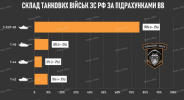1. Summarized conclusions (brief content)
The study was prepared and implemented by the collaboration of the platforms
Resurgam ,
Military Fortune Teller and
Mortis Aeterna .
Our calculation showed that within 5-7 months, the central bases of the tank reserve were emptied by almost 400 tanks.
The average rate of depletion of bases is up to 70 units per month. This rate makes it possible to cover current losses, but its stability throughout 2023 and early 2024 (and other factors, which are detailed in the text) indicates that the "ceiling of scaling" of production/modernization/recovery of tanks has been reached.
An analysis of the main armored factories showed a large overcrowding of sites, which indicates the overload of these factories, and not only that.
In the studied area, we covered up to 95% of the main places where "enemy tank reserves" could be stored. Our calculation showed that
3,150 tanks at the central bases of the tank reserve and
1,300-1,500 tanks at the waiting areas and near the workshops of the main armored repair plants remain suitable for deconservation/restoration.
This amount of the enemy should be enough to support the restoration of tanks without interruption
until the beginning of 2026.
Against the background of other information, we singled out three main scenarios for the depletion of the enemy's tank reserves: "optimistic" - 12-18 months; "moderate" - 18-24 months and "pessimistic" - more than 24 months.
-
2.2 Counting the number of tanks at the central bases of the tank reserve
Tanks without turrets and tanks in disposal areas, which are almost completely disassembled for spare parts and are not even eligible as "donors" for spare parts, were not taken into account at the storage bases. Our conservative calculation gave the following results, which we summarized in a comparison table

 Bases without recent images are marked with asterisks *.
Bases without recent images are marked with asterisks *.
Due to possible errors, the number of "good" tanks at these bases may fluctuate around 3050-3250 units.
-
2.3 Counting of tanks at the waiting areas of the main armored tank repair plants

-
2.4 Conclusion from the calculation of CBRT and BTRZ
In total, there are 3,050-3,250 "good tanks" at the bases (although the issue of their quality is also debatable, but we remind you that our calculation is as conservative as possible towards the "worst" option for us) + 1,300-1,500 tanks are waiting at factories for restoration/modernization or use in as a spare parts donor. These tanks are in very different conditions, but we took them into account.
So, counting almost all the main places (up to 95%) of the potential concentration of the enemy's tank reserve, it is possible to call a figure of 4300-4750 tanks that can potentially be restored or used as donors. At other small bases, there are almost no tanks left, or they are counted in units.
In general, the resource of 4300-4650 tanks with the current rate of losses is enough for Moscow to provide uninterrupted repair and recovery of losses for 2-2.5 years. Potentially by early 2026.
Another question is that we say 2-2.5 years with the condition of using reserves at 0, but the key is the "recovery pace" because for a long time the main tank repair plants have huge queues due to the inability to quickly restore the tanks placed for restoration. Each subsequent time, the de-conserved tanks will leave in a worse condition, which will require more time and components to restore them.
Therefore, the production capacity of armored tank repair plants will determine the pace of tank recovery and production, and, therefore, its depletion.
What we will talk about in the next chapter.
3. The main questions to which we were looking for answers
3.1 What do Western analysts say about Moscow's recovery/production of tanks?
The biggest problem in the context of Western analyst estimates of tank recovery/production rates is that they do not articulate the difference, so most claim that Russia is "producing" 100 tanks per month, which is not true.
According to Andrii Tarasenko, Moscow is able to "produce from scratch" approximately 60 T-90M tanks per year. For example, as of September 2023, UVZ
was working on the production of the 192nd tank out of the 270 units ordered under the contract in the period 2017-2021.
To the credit of the Ministry of Defense of Great Britain, in its updates, mentioning the figure of "100 tanks per month", the Ministry of Defense uses the verb "generate", i.e. "generates" - in this way, both produced, modernized and decommissioned tanks are taken into account defects, but did not undergo modernization before being sent to the front.
Pavel Luzin can be considered a "conditionally Western" analyst, since he works at the Western think-tank The Jamestown Foundation. So he
estimated the "production" (that is, "from scratch" and deep modernization) of tanks in Moscow at a maximum of 200 units per year (15-20 per month "from scratch").
Our research has revealed that the rate of de-conservation of tanks is approximately 77 units per month over the past 5 months. Maybe a little more, a little less depending on the month and the exact date of the picture. If we add 15-20 produced from scratch to the 77 de-canned tanks, then we arrive at an approximate rate of 100 tanks per month, as stated by Western intelligence and researchers. Only the share of truly new (produced) is only 1/5 - everything else is reserves from storage bases, which also have their limits.
3.2 What is the potential of this recovery/production? What is the ceiling of this recovery and what factors (production, human, technological) does this recovery rely on?
Taking into account long-term observations, assessment of rates, analysis of not one, not two, and even not three studies, we come to the conclusion that the potential for increasing the production of new tanks has already reached its scaling peak, even despite the available financial resources for this scaling.
For example, in 2021, according to Andrii Tarasenko's calculations, Moscow managed to produce 80 T-90M tanks - this is taking into account the available warehouse stocks of components, which were partly exported and which were purchased under three-year programs. Therefore, now (relatively speaking) the main Western components were purchased not as part of "parallel imports", but were already available thanks to the corresponding stock of components, which was created for 2022-2024/25 under contracts even before February 24. Now this stock is being actively depleted due to the need to massively modernize and raise tanks from storage bases. As these reserves are exhausted, the key issue will not be the circumvention of sanctions, but the time required to ensure this circumvention and the expenditure of additional financial resources to ensure this circumvention.
Despite
the increase in the production of machine tools from 5458 units. in 2021 to 7,743 units. for January-September 2023 and transfer of production to 3-4 variable forms, we are skeptical about the further scaling of the potential of modernization of equipment. Collectively, we come to the conclusion that, as of now, Muscovy has probably reached the "production ceiling".
The "production ceiling" rests on a number of factors:
- Employment in the military industry is no longer growing , although production is limited by a chronic shortage of workers.
- Due to the increased wear and tear of the equipment due to the increase - or, more precisely, the return of production rates to the indicator of 2015-2017.
- An increase in labor hours on the product due to a lack of Western components, spending more time on their import substitution or the use of parallel import methods to circumvent sanctions.
And here it is worth mentioning once again one already mentioned detail, that our calculation recorded the approximate rate of depletion of storage bases at 77 tanks per month (average value). This roughly correlates with what the Covert Cabal tracked in their research throughout 2023. That is, approximately the same pace is maintained at the beginning of 2024. It can be assumed that where Moscow scales the production/restoration of tanks there is a "negative compensation" with the need to restore tanks from storage bases that are already in a worse condition. Therefore, the number remains plus or minus in one corridor.
3.3 Has the pace of production expansion/restoration reached its ceiling in Moscow?
Let's detail the answer again, in our collective opinion, the pace of production/decommissioning and restoration of tanks has reached its ceiling and will continue to decline, since the Russians have already mostly deconserved tanks in the "best" condition. In principle, tanks of even 4-5 categories that can be classified as "scrap" are subject to restoration and potential modernization - it's only a matter of time and capabilities, which depend on a large number of factors, including the availability of components and the real possibility of their production.
Our estimates, in principle, even do not contradict the data of the Muscovites themselves about 1,200-1,500 "manufactured" tanks for 2023, only if we consider that "manufactured" includes: both newly manufactured, and de-conserved, and modernized, and those already visited the battlefield, suffered damage there and were repaired in one of the factories - or even in field workshops.
3.4 Why is the key thing now not how many tanks are still on the bases, but how quickly the Moscow Military Industry is able to raise them? Is it so?
In fact, the key question is whether the Muscovites will receive armored vehicles from their allies, primarily the DPRK and Iran, as well as the PRC (which is less likely, but such a prospect cannot be dismissed). If we put this question in parentheses, then what is important is not so much the rate of recovery of tanks per se, but the comparison of the rate of recovery with the current losses at the front. For example, the Australian YouTuber Perun once published a video, the text translation of which can be viewed at
the link , in which he noted that under the best possible conditions, quote: "
If you can't recover losses quickly enough - under such a scenario, the army can hypothetically fight until the difference between losses and the combination of production and recovery will not be sufficient to dilute the active combat power of the army and render it incapacitated .
If the Russians produce new equipment at a rate that will exceed the rate of losses - for example, under conditions of an armistice or freezing of the conflict, or simply an insufficient number of weapons in the Armed Forces - then the Moscow army will actually be able to update and modernize online. But this is in the case of an adequate assessment of one's own capabilities by the enemy's military leadership.
Although recent months and attempts at "banzai attacks" gave Moscow certain territorial gains, they were incomparable with the losses for the sake of these gains. Such "zeal" can be explained by "political motives": to achieve a result before the elections, then to make the most of the exhaustion of the Armed Forces against the background of the Americans' partner negligence, to achieve as many territorial gains as possible with the conviction that Moscow will be able to freeze the conflict from the US elections.
4. Scenarios of depletion of enemy tank reserves
Based on the collected information, we can build basic scenarios for the depletion of Moscow.
Optimistic (12-18 months). Depletion of tank reserves by increasing the intensity of battles.
Visually confirmed losses of enemy tanks in 2023 amount to 866 units. These are visually confirmed, let's add at least 30% (most conservatively) that were not recorded on the open Internet and we will get 1125 tanks were lost during 2023. That is, the average loss rate is 93 units. month. That is, now the production/restoration of tanks from scratch covers this need with its 100 units. per month, which was discussed earlier. As of now, the actual number of tanks involved in Ukraine is from 2,200 to 2,500 units. That is, in order for the rate of losses to reduce the available combat capability, it is necessary that the monthly losses of the enemy in tanks are at the level of 160-170 units. Then the balance between losses and production for 12-18 months will lead to a critical loss of combat capability of the units, because according to the roster there should be 4,300 tanks, but in fact there will be only ¼ of them.
Moderate (18-24 months). Depletion of the main reserves of tanks at storage bases. The intensity is maintained, Muscovy is able to restore its own losses by attracting reserves from storage bases, restoration, cannibalism. As it was stated, at this rate (actually as it is now), provided there is no external aid (in the form of the transfer of tanks and spare parts for them), Moscow can hold out until the beginning of 2026. After that, it will be able to replenish the losses only through real production "from scratch", which satisfies only 1/5 of the actual needs of the front.
Pessimistic (over 26 months). Muscovy will begin receiving direct deliveries of heavy weapons in the form of tanks from Iran, the DPRK, and possibly China. This option requires separate consideration, as it includes a whole set of factors: from the political readiness of these countries to the actual number of combat-ready tanks and their types.
As of now, in the contexts in which we are now, we are inclined to the "moderate" option, which states that by the beginning of 2026, Moscow will be able to maintain the necessary level of combat capability of its tank units.




 . Nyt jumaliste päätöksiä ja nopeasti, historia ei tule antamaan anteeksi, jos taas tämäkin sössitään!
. Nyt jumaliste päätöksiä ja nopeasti, historia ei tule antamaan anteeksi, jos taas tämäkin sössitään! To answer these questions,
To answer these questions,  Our calculation showed that within 5-7 months, the central bases of the tank reserve were emptied by almost 400 units. tanks
Our calculation showed that within 5-7 months, the central bases of the tank reserve were emptied by almost 400 units. tanks



